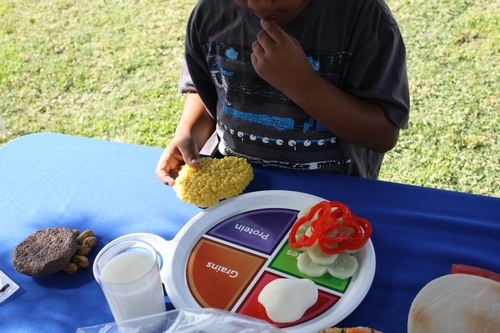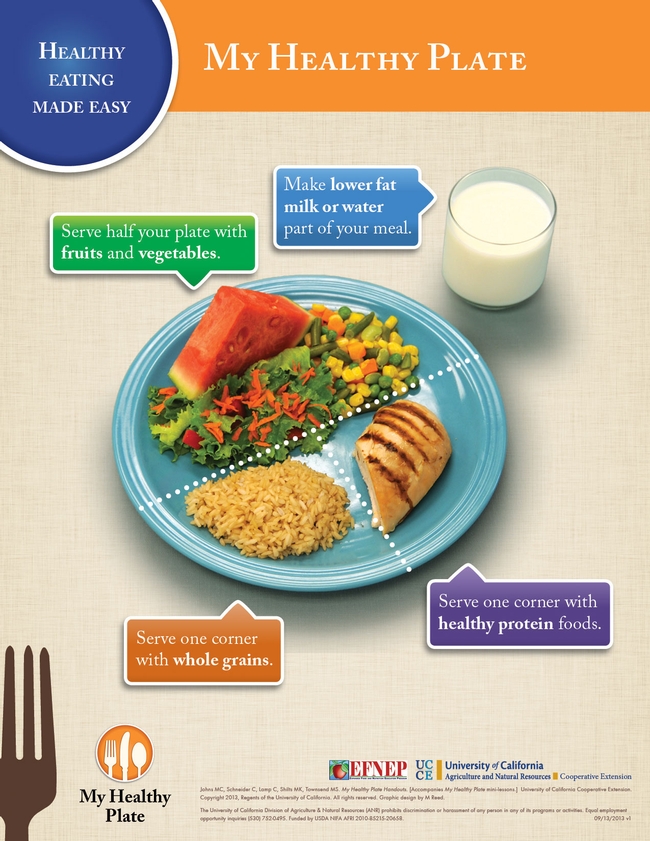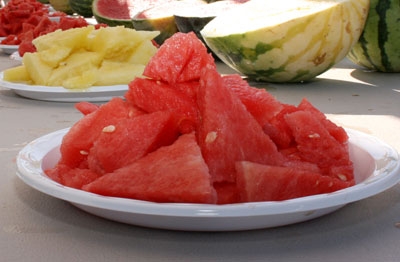
Posts Tagged: Cathi Lamp
Picture this: UCCE focuses on healthy meals for Healthy Weight Week (Jan. 18-24)

In 2011, the U.S. Department of Agriculture unveiled a new food graphic, MyPlate, to remind consumers to choose healthier foods. Work by Cooperative Extension in California that began years earlier influenced the adoption of MyPlate by USDA. Nutrition educators in California began using a plate graphic with USDA's My Pyramid several years ago in a research project with Expanded Food and Nutrition Education Program (EFNEP) and UC CalFresh Nutrition Education Program participants. While evaluating the use of their graphic, which was very similar to USDA's MyPlate, UC Cooperative Extension nutrition advisors found that a graphic depiction such as the one USDA is using for MyPlate is abstract for many families.
“We discovered that our clients need to see photos showing real food combinations in order to apply the MyPlate message to real food choices,” said Cathi Lamp, UC Cooperative Extension nutrition advisor. “They prefer to learn by viewing photographs with foods and meals they eat to see how it works and how they can implement the guide in their lives.”

They evaluated the behavior of consumers who were trained with the revised Plan, Shop, Save and Cook curriculum with photos of food and compared it with the results of the original version of the lessons.


“Everybody enjoys looking at pictures of foods,” said Lamp. “So what we have now in our nutrition classes are lots of photographs of healthy examples.”
To listen to an interview with Cathi Lamp about My Healthy Plate in Spanish, visit Enseñando a comer ‘con sabor latino' con MiPlato at http://ucanr.edu/sites/Spanish/Noticias/radio/?uid=5983&ds=199.
For more than 100 years, the University of California Cooperative Extension researchers and educators have been drawing on local expertise to conduct agricultural, environmental, economic, youth development and nutrition research that helps California thrive. UC Cooperative Extension is part of the University of California's systemwide Division of Agriculture and Natural Resources. Learn more at ucanr.edu.
Food banks in Fresno and Tulare consider merger

The Visalia Times-Delta reported that UC Cooperative Extension was one of the organizations represented at a meeting about the potential merger last Friday, which also included Kaweah Delta Healthcare District, Pixley-based Be Healthy Tulare and United Way of Tulare County.
“I guess one of my fears is there is an inherent distrust of Fresno,” the story quoted Cathi Lamp, nutrition, family and consumer sciences advisor for UCCE in Tulare County and a former FoodLink board member. Lamp said she is concerned the merged food bank would be based in Fresno County, and Tulare County's needs might be ignored.
Julie Cates, UCCE nutrition program coordinator, told me FoodLink of Tulare County has long focused on distributing quality, nutrient dense products and partnering with agencies, such as UCCE, to provide nutrition education.
"We were able to have our teachers at the school receiving the 'farmers market' write testimonial emails and one teacher submitted letters from the fourth-grade students," Cates said. "I am very pleased with this outcome, as it illustrates how the food distributions are migrating from the inner to outer circles of the social ecological model in which we are striving to serve, reflecting universal behavior change."
View a one-minute video about one of the collaborative projects conducted by FoodLink of Tulare County and UCCE Tulare County:
The weight of the nation

The film, titled “Children in Crisis,” is the third part of the HBO series “The Weight of the Nation." The film will show at 1 p.m. Friday, Sept. 21, at the Agriculture Building Auditorium, 4437 S. Laspina St., Tulare.
Obesity is an on-going issue in Tulare County, Cathi Lamp is quoted in the article. Lamp is the UC Cooperative Extension advisor in Tulare County for nutrition, family and consumer sciences.
She is no stranger to the health issues that plague the county’s children. Lamp has been part of campaigns to stop people from drinking sugary drinks and to encourage healthful eating habits as well as incorporate physical activity into their lives, the article said.
Eating right doesn’t have to break the budget
Even though dietitians have for decades strongly recommended eating lots of fruit and vegetables daily, very few Americans hit the mark. Food prices, taste, inconvenience, and a failure to understand the link between diet and health have been blamed for Americans’ poor food choices.
New research by the USDA Economic Research Service dispels one of those obstacles. The study determined that buying the recommended amount of fruits and vegetables costs on average only $2 to $2.50 per day.
“For those with access and the means to buy them, the assertion that fruits and vegetables are too expensive is not a good excuse,” said UC Cooperative Extension nutrition, family and consumer sciences advisor Cathi Lamp. “Consumers should be able to purchase a days’ worth of fruit and vegetables for less than it costs to buy a cheeseburger.”
The ERA researchers estimated the average retail prices of 153 fresh and processed fruits and vegetables. Processed fruits and vegetables included frozen, canned and dried plus 100 percent fruit juice. They also estimated the average price per edible cup for each vegetable and fruit.
Costs in the study were defined as the average prices paid by all American households for a food over a one-year period, including purchases in different package sizes, under different brand names and at different types of retail outlets (including supercenters such as Wal-Mart, wholesale club stores like Costco, traditional grocery stores such as Safeway, Kroger and Albertsons, and convenience stores.)
The research indicated that:
- Fruits and vegetables cost about 50 cents per edible cup.
- The lowest average price for any of the 59 fruits in the study was for fresh watermelon, at 17 cents per cup. The highest average price was for fresh raspberries, at $2.06 per cup.
- Among the 95 fresh and processed vegetables in the study, a cup of dry pinto beans was the least expensive at 13 cents. The most expensive was frozen asparagus cuts and tips at $2.07 per cup.
- Processed fruits and vegetables were not consistently more or less expensive than fresh produce, but with certain types of produce, the prices varied quite a bit. Canned carrots, at 34 cents per cup, were more expensive than fresh carrots, at 25 cents per cup. However, canned peaches, at 58 cents per cup, were less expensive than fresh, at 66 cents per cup.
Lamp suggested smart shopping can also help consumers reduce the cost of their fruits and vegetables. For example, buy fresh fruit and vegetables in season, use canned and frozen fruit and vegetables when it is cheaper and stock up when items are on sale or when shopping at a supercenter or wholesale club.

USDA says fresh watermelon is, on average, the least expensive fruit.
A new approach in teaching healthy eating
UC Cooperative Extension nutrition educators have discovered that, when it comes to teaching consumers how to eat right, a picture is worth of thousand words.
“We’ve been teaching people for years about MyPyramid and the dietary guidelines, serving sizes and the number of servings they should eat, but many were having a hard time translating that to what exactly to put on their plates,” said Cathi Lamp, the nutrition, family and consumer sciences advisor for Tulare County UCCE.
In an effort to simplify nutrition education, UCCE started with a graphic of a plate, with half designated for fruits and vegetables and a quarter each for protein and grains. However, the concept was still too abstract for concrete thinkers.
“Then we hit upon the idea of photographing familiar foods in the right proportions and showing actual serving sizes arranged on a plate,” Lamp said.
Lamp, and the nutrition, family and consumer sciences advisors for Fresno County, Connie Schneider, and Kern County, Margaret Johns, set out to review 24-hour recall surveys that had been conducted by participants in UCCE nutrition education classes. The 24-hour recall surveys, a mainstay in nutrition research, ask participants to write down everything they have eaten in the previous 24 hours. Each of the advisors focused on recalls from target population groups – Latinos, African-Americans and the general population.
Once they knew what foods people eat, Lamp, Schneider and Johns began the labor-intensive process of preparing and photographing test pictures showing healthy food combinations. Meals included chicken, pizza, spaghetti, sandwiches, tacos, pork chops, fish, stir fry, hamburger, soup and eggs.
Eighteen plates of food were photographed for initial, informal testing. Lamp took the photos to an education session at the local WIC office, where pregnant women and new mothers receive federal nutrition support.
“We handed out a little form and asked the moms if they could identify the foods, whether these were foods they would eat and, if not, what changes they would make,” Lamp said. “The WIC educators loved the images. They could see the value of images of healthy food right off the bat.”
The next step will be cognitive testing of the photos with target clientele, adjustment of the photos based on the results of the testing, retesting the photos in a nutrition education setting and analyzing the results.
Cathi Lamp explains food plate design process.
